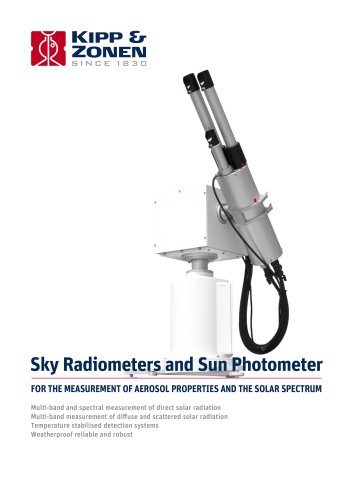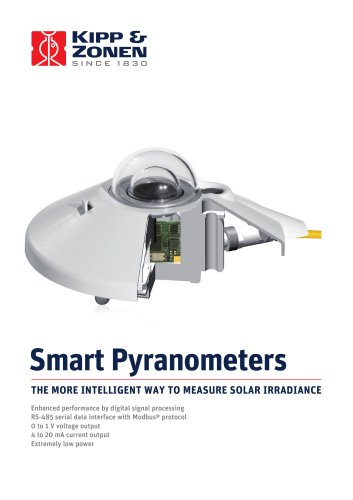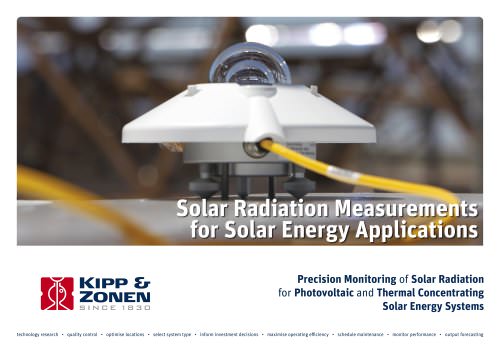
カタログの抜粋

Upgrade of the solar monitoring system RaZON to full weather station by Joop Mes, Xander van Mechelen and Marc Korevaar of Kipp & Zonen B.V. Delft, the Netherlands INTRODUCTION Most accurate measurement of components of Solar Radiation: • Solar tracker with pyrheliometer for DNI, pyranometer for GH and shaded pyranometer for Diffuse Alternative systems • SPN1 sunshine pyranometer (Delta T) • RSR2 rotating shadowband (Irradiance) RaZON+ solar monitoring system (left picture) • Solar tracker including pyrheliometer, shaded pyranometer and GPS • PH1 smart pyrheliometer: new design pyrheliometer, inherently low fouling sensitivity • PR1 smart pyranometer: designed for diffuse measurement • All devices communicate by Modbus® RTU protocol • Solar tracker aggregates measurement of DNI and Diffuse components and calculates GH and sunshine duration • GPS for solar position, accurate timing • Gear drive tracker • On-board data logger • External Modbus® RTU weather instruments can be connected and logged (NEW) • Installation, alignment and monitoring via smartphone, tablet or laptop using optional WiFi • Ethernet and RS-485 (Modbus® RTU or ASCII serial) to download stored data COMPARISON OF SYSTEMS MEASURING SOLAR COMPONENTS • BSRN type system: 2AP tracker with CHP1, CMP21 and shaded CMP11 • SPN1 • RSR2 • RaZON+ We evaluated the different solar monitoring systems on a private rooftop at Almere, the Netherlands. The roof setup of all instruments together and individually are shown in figure 3. We analysed the DNI, GHI and DHI over a period from 18th to 29th of July containing both cloudy and clear days. The differences between the 3 evaluated systems and the reference system were evaluated. For this we calculated the bias, the RMSE due to variability and performed a ‘box and whisker’ analysis similar in approach to previous comparisons [8]. PYRHELIOMETER DESIGN PH1: pyrheliometer with reduced soiling sensitivity • Amount of soiling particles that reach the diffusor is lower than for the • Diffusor is less sensitive for soiling particles than a window since due to its’ scattering properties POINTING ACCURACY TEST RaZON+ • Evaluation using a pinhole and a CCD camera (a) Pointing accuracy apparatus consisting of a brass tube with a pinhole in aluminium at the left and a CMOS camera at the right end (b) the sun image on the apparatus (c) a pointing angle density plot over 2200 image frames of the sun projection centre. Table 1 RMSE due to variability and bias for the 3 systems for DNI, GHI and DHI. System The pointing accuracy of the RaZON+ was evaluated to be within a circle of 0.1° diameter, for short time periods. Comparison of the 3 solar monitoring systems to a reference solar monitoring station shows the best performance of the three to be for the RaZON+. The RMSE due to variability for the RaZON+ is significantly smaller than for the RSR2 and the SPN1. The bias is smallest for the RaZON+ for DNI and DHI but for GHI the SPN1 has the smallest bias. Likely this is because the tests were on a pre production system with not yet all the regular calibration procedures in place. The RaZON+ now interfaces with automatic weather stations, plane of array (POA) pyranometers, PV panel temperature sensors and with DustIQ soiling measurement, working as a data hub or datalogger. C.A. Gueymard, “Direct Normal Irradiance for CSP/CPV: Modeling Challenges”, presentation. J. Badosa, J. Wood, P. Blanc, C.N. Long, L. Vuilleumier, D. Demengel, and M. Haeffelin, “Solar irradiances measured using SPN1 radiometers: uncertainties and clues for development”, Atmos. Meas. Tech., 7, 4267-4283, 2014. N. Geuder, M. Hanussek, J. Haller, R. Affolter, and S. Wilbert, “Comparison of Corrections and Calibration Procedures for Rotating Shadowband Irradiance Sensors”, Solar PACES Granada Spain, 2011. A. Habte, S. Wilcox, and T. Stoffel, “Evaluation of Radiometers Deployed at the National Renewable Energy Laboratory’s Solar Radiation Research Laboratory”, NREL. Modbus® PowerSupply Junction Box RS-485 Modbus® optional devices D.R. Myers, “Comparison of direct normal irradiance derived from silicon and thermopile global hemispherical radiation detectors”, NREL. INTEGRATED DATA LOGGING W. Jessen, S. Wilbert, B. Nouri, N. Geuder, and H. Fritz, “Calibration methods for rotating shadowband irradiometers and evaluation of calibration duration”, Atmos. Meas. Tech. Discuss., 8, 10249–10282, 2015 N. Geuder, F. Trieb, C. Schillings, R. Meyer, and V. Quaschning, “Comparison of different methods for measuring solar irradiation data”, 3rd International Conference on Experiences with Automatic Weather Stations Torremolinos Spain, 2003. L. Vuilleumier, M. Hauser, C. Félix, N. Sommer, D. Ruffieux and B. Calpini, “Performance Evaluation of Radiation Sensors for the Solar Energy Sector”, MACC-II Open Science Conference Brussels Belgium, 2014. M. Korevaar, J. Heemskerk, M. Goorden, and F. Beekman, “Multi-scale algorithm for improved scintillation detection in L.J.B. McArthur, “BSRN operators manual”, version 2.1, 2005, www.wmo.int/pages/prog/gcos/documents/gruanmanuals/WCRP/WCRP21_TD1274_BSRN.pdf a CCD-based gamma camera”, Physics in Medicine and Biology 54, 2009. We would like to thank A. Staupe and the Staupe
カタログの1ページ目を開くOTT HydroMetのすべてのカタログと技術パンフレット
-
KZ Sun Tracker
2 ページ
-
Albedometers
2 ページ
-
DustIQ - Brochure
2 ページ
-
METEON 2.0
1 ページ
-
CNR series
2 ページ
-
Newsletter 43
12 ページ
-
Newsletter 44
16 ページ
-
Newsletter 45
8 ページ
-
AirShield® DNI
2 ページ
-
RaZON
4 ページ
-
SMP10 Pyranometer
2 ページ
-
The New CMP10
2 ページ
-
Albedometers
2 ページ
-
CM 121 Shadow Ring
2 ページ
-
Pyrheliometers
4 ページ
-
Pyrgeometers
4 ページ
-
AMPBOX
2 ページ
-
AirShield Handout
2 ページ
-
SP Lite2
2 ページ
-
Pyranometers
8 ページ
-
RT1
2 ページ
-
RaZON+
4 ページ
-
Sun Trackers
2 ページ
-
LAS MkII
4 ページ
-
Brewer MKIII
4 ページ
-
Data Loggers
4 ページ
-
Net Radiometers
4 ページ
-
UV Radiometers
4 ページ
-
CMA Albedometers
2 ページ
-
CGR Pyrgeometers
4 ページ
-
CM 4 Pyranometer
2 ページ
カタログアーカイブ
-
CNR 1 Net Radiometer
2 ページ

























































